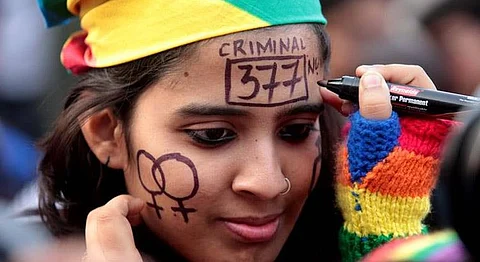
- HOMEGROWN WORLD
- #HGCREATORS
- #HGEXPLORE
- #HGVOICES
- #HGSHOP
- CAREERS
- ABOUT US
- CONTACT US

Today, February 2, marks a historic day for India. This afternoon, the Supreme Court directed the curative petition against Section 377 of the Indian Penal Code, which is used to target India’s LGBTQI community, to be listed before a larger bench of five judges who will consider reopening the case.
In 2009, the Delhi High Court had struck down Section 377 deeming it unconstitutional. LGBTQI Indians everywhere rejoiced. People found the courage to come out of the closet and be proud of who they were. Numbers of attendees at the annual pride parade swelled and queer-friendly events and spaces blossomed. Sadly, it was short lived, as in 2013 the Supreme Court dealt a deadly blow to India’s growing gay rights movement when it overturned the 2009 HC verdict, claiming that it was not a matter for the courts to decide gay rights, but for legislature (the parliament) instead. While many urban LGBTQI Indians who had tasted freedom—having been empowered thanks to the absence of the shadowy spectre of 377 hanging over them—refused to go back in the closet, there were still millions for whom life and time seemed to have regressed. In the years that followed, hundreds were booked under Section 377 and India’s LGBTQI community was forced back underground.
Just over two years later, a bench at the Supreme Court today headed by Chief Justice of India T.S. Thakur heard the curative petitions against the reinstatement of Section 377. This curative petition was the last legal recourse for India’s LGBTQI community. If the Supreme Court had refused to hear it today, it would once again have been left to parliament to amend the law. During the parliament’s last brush with it, when Shashi Tharoor tried to submit a private member’s bill, they laughed him off the floor voting 71-24 against it before it could even be tabled for discussion.
Naz Foundation director Anjali Gopalan, who was one of the hundreds huddled outside the Supreme Court of India this winter morning, told NDTV: “It is a day of great relief. If they decided not to hear it at all, it would have been the end of the road legally. But the fact that they thought it was important enough to listen and refer it to a five-judge bench is huge. When we started this fight we knew it wasn’t going to happen overnight. The reversal of the HC judgment left us completely winded and it took a lot to get out of that. But this gives us some hope.”
Lots of people were hoping that the Supreme Court would just scrap Section 377. But it’s not that simple. Even the apex court couldn’t just do away with a section on a whim. Today’s hearing was simply to review the curative petition—and it’s been a great hearing. Many may not see this as a victory, but it is most definitely one. And a historic occasion as well. Only two curative petitions in history have ever been reviewed. The fact that today’s petition is only the third, and is one pertaining to a community that was not too long ago referred to as a ‘minuscule minority’ whose rights didn’t seem to matter, is perhaps a sign of better things to come.
So far, there has been no word on the date for the hearing, nor the names of the five judges who will constitute the bench. But in the meantime, India’s LGBTQI community is rejoicing. And considering Mumbai’s Queer Azadi March (the annual pride parade) is on Saturday, February 6, expect the giant rainbow flags to fly higher and prouder than they have in the recent past.
Words: Neville Bhandara
Feature image courtesy of Indian Express
